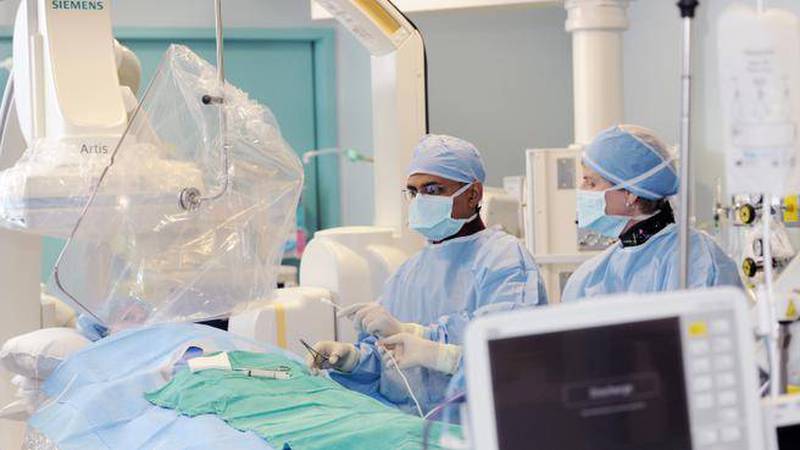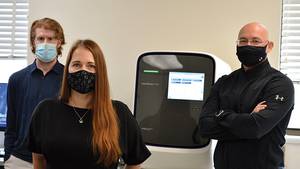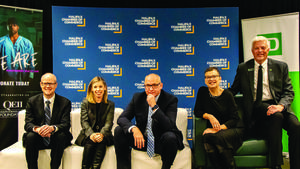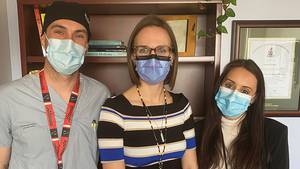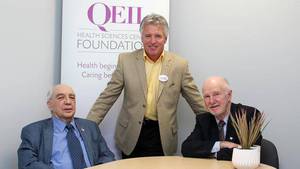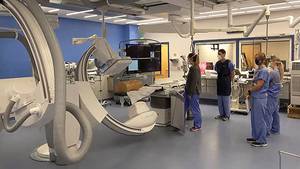The dramatic improvements Dr. Jai Shankar has witnessed in patients— because of recent advances in stroke treatment—gives him renewed hope for the hundreds of patients seen every year by the QEII Health Sciences Centre’s acute stroke service.
“Our understanding of stroke has grown tremendously,” says Dr. Shankar, a
By advancing stroke research and treatment in recent years, most importantly with a new technique called endovascular thrombectomy (EVT), Dr. Shankar and his colleagues at the QEII have established a new standard of care in Nova Scotia for treating acute ischemic stroke patients.
“EVT is the biggest advance in stroke treatment in two decades,” says Dr. Stephen Phillips, a stroke neurologist at the QEII.
In 2011 Dr. Shankar performed the first EVT on a stroke patient in Nova Scotia. EVT is a technique in which a catheter is threaded into the head through an artery in the leg, extracting the stroke-causing clot from the blood vessel in the brain. Part of a large clinical trial initially, the treatment has since produced amazing results in routine practice by dramatically reducing the degree of disability experienced after the stroke, enabling people to make better recoveries.
“If we don’t treat these patients, their recoveries are slower and less complete,” says Dr. Shankar.
Studies have shown that for every 100 patients treated, 38 will be less disabled after receiving EVT treatment, and 20 more will be able to function independently, says Dr. Phillips.
Dr. Shankar has witnessed some of these amazing results. One stroke patient, who couldn’t move half of his body, reached out to grab something on the operating table immediately after the treatment.
Not only are the results dramatic for patients, but they have translated into shorter hospital stays, he says.
“This has definitely revolutionized stroke treatment. It is now a standard of care across Canada,” says Dr. Shankar. “Research will continue and we will continue to evolve further,” he adds.
In Nova Scotia, patients can only receive the treatment in Halifax. In 2015, 20 patients received EVT treatment, but that number nearly doubled in 2016.
About 10 per cent of acute ischemic stroke patients may be eligible for EVT, says Dr. Phillips. In Nova Scotia, that means that about 120 patients per year may be suitable.
That’s good news for the close to 450 patients admitted annually to the QEII’s acute stroke unit. Providing the treatment for patients province-wide is currently being addressed by the Nova Scotia Health Authority.
Stroke continues to be a leading cause of death and disability in the province. Most strokes are ischemic, resulting from the blockage of a blood vessel in the brain.
Research has shown that if doctors can treat patients quickly, they can see dramatic results after an acute ischemic stroke, says Dr. Shankar.
For patients, this means they must get to the hospital as soon as possible to receive treatment that may save their lives and dramatically reduce their disability.
The first priorities in the emergency department are to verify the diagnosis of acute ischemic stroke, and – whenever possible – administer the clot-busting drug t-PA without delay and not later than 4.5 hours after stroke onset. Determining eligibility for EVT occurs in parallel. Doctors make the decision about EVT from the location and size of the blood clot seen on a special CT scan, and the amount of time that has elapsed since stroke onset.
Knowing the signs of a stroke — drooping face, inability to lift both arms, slurred or jumbled speech —and acting immediately gives the best chance of a good outcome.
“If you or someone around you has stroke symptoms, call 911,” says Dr. Phillips.“All the scientific research has shown us that we have to act quickly.”

